Grid Layout in Windows Forms GridGrouping control
21 Jan 202524 minutes to read
GridGroupingControl offers different layouts to organize the display of data. This section will discuss some of the features offered by GridGroupingControl for layout customization.
Stacked Headers
GridGroupingControl offers in-built support for Stacked Multi-Headers. This feature allows user to create additional unbound header rows called StackedHeaderRows that span across visible grid columns. User can group some columns under each header row. It also supports Drag/Drop of these header rows. Grouped columns will also be rearranged along with the header.
Stacked Header rows for a given grid are gathered under TableDescriptor.StackedHeaderRows collection. This contains property definitions that control the behavior and appearance of stacked headers.
Every header in a Stacked Header Row is defined by GridStackedHeaderDescriptor. All the headers for a given stacked header row is managed by GridStackedHeaderRowDescriptor. GridStackedHeaderRowDescriptorCollection, which is returned by TableDescriptor.StackedHeaderRows property manages the collection of GridStackedHeaderRowDescriptor for a given table.
// Step 1: Creating StackedHeaderDescriptor for adding stacked columns
// “header1” denotes the name of the GridStackedHeaderDescriptor
// “StackedHeader1” denotes the display text of the GridStackedHeaderDescriptor
GridStackedHeaderDescriptor stackedHeaderDescriptor = new GridStackedHeaderDescriptor("header1", "StackedHeader1");
// Step 2: Adding visible columns to the StackedHeaderDescriptor
stackedHeaderDescriptor.VisibleColumns.Add(new GridStackedHeaderVisibleColumnDescriptor("EmployeeID"));
stackedHeaderDescriptor.VisibleColumns.Add(new GridStackedHeaderVisibleColumnDescriptor("FirstName"));
stackedHeaderDescriptor.VisibleColumns.Add(new GridStackedHeaderVisibleColumnDescriptor("LastName"));
// Step 3: Adding StackedHeaderDescriptor to the GridStackedHeaderRowDescriptor collection
GridStackedHeaderRowDescriptor stackedHeaderRowDescriptor = new GridStackedHeaderRowDescriptor("Row1",
new GridStackedHeaderDescriptor[] { stackedHeaderDescriptor });
// Step 4: Add the GridStackedRowHeaderDescriptor collection to the StackedHeaderRows
this.gridGroupingControl1.TableDescriptor.StackedHeaderRows.Add(stackedHeaderRowDescriptor);' Step 1: Creating StackedHeaderDescriptor for adding stacked columns
' “header1” denotes the name of the GridStackedHeaderDescriptor
' “StackedHeader1” denotes the display text of the GridStackedHeaderDescriptor
Dim stackedHeaderDescriptor As New GridStackedHeaderDescriptor("header1", "StackedHeader1")
' Step 2: Adding visible columns to the StackedHeaderDescriptor
stackedHeaderDescriptor.VisibleColumns.Add(New GridStackedHeaderVisibleColumnDescriptor("EmployeeID"))
stackedHeaderDescriptor.VisibleColumns.Add(New GridStackedHeaderVisibleColumnDescriptor("FirstName"))
stackedHeaderDescriptor.VisibleColumns.Add(New GridStackedHeaderVisibleColumnDescriptor("LastName"))
' Step 3: Adding StackedHeaderDescriptor to the GridStackedHeaderRowDescriptor collection
Dim stackedHeaderRowDescriptor As New GridStackedHeaderRowDescriptor("Row1", New GridStackedHeaderDescriptor() { stackedHeaderDescriptor })
' Step 4: Add the GridStackedRowHeaderDescriptor collection to the StackedHeaderRows
Me.gridGroupingControl1.TableDescriptor.StackedHeaderRows.Add(stackedHeaderRowDescriptor)Adding Stacked Headers through Designer
To add the stacked headers in GridGroupingControl in designer mode, follow the below steps.
-
Open GridStackedHeaderRowDescriptor Collection Editor by using the
StackedHeaderRowsproperty which is available under theTableDescriptorproperty. Using this collection editor, user can add header rows by specifying different attributes like HeaderText, VisibleColumns, Appearance and so on.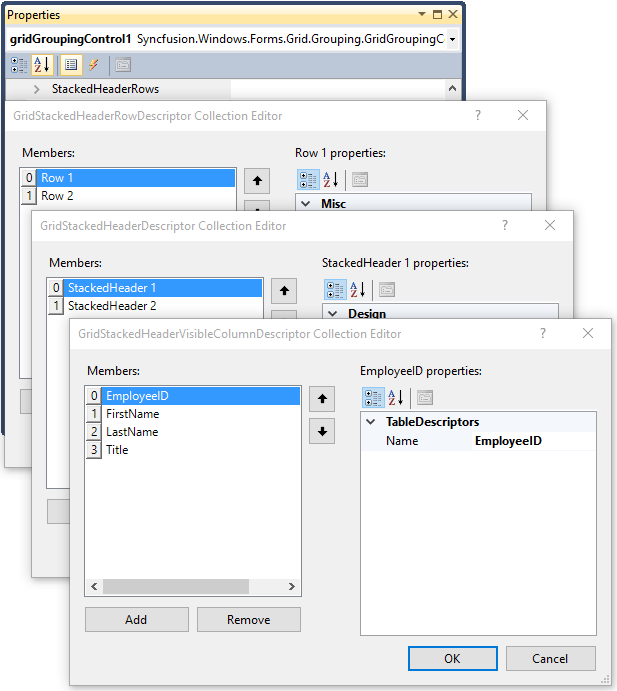
-
Enable the ShowStackedHeaders property to display the stacked headers for the table and groups.
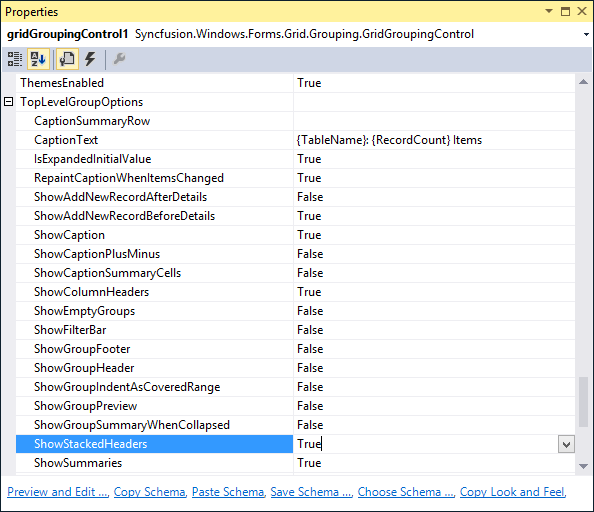
The below screen shot shows the grid with stacked headers.
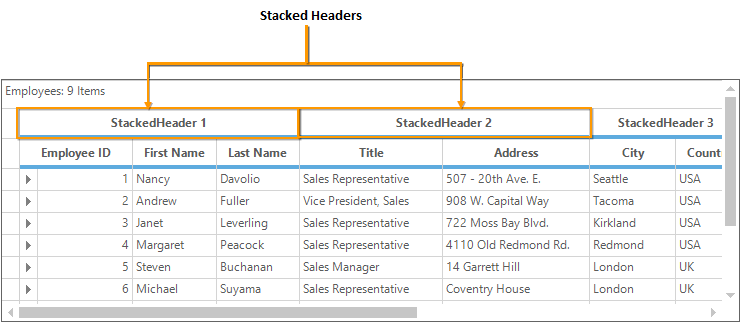
-
Visible columns gets affected automatically while rearranging stacked headers as of follows,
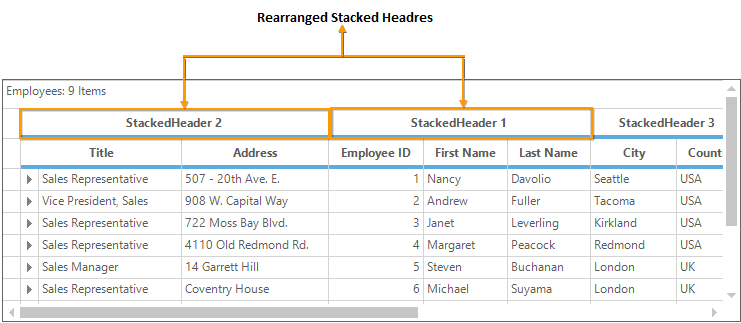
NOTE
The stacked headers will be generated if the added columns in the stacked headers are presented in the Columns collection. So the stacked headers are depending upon the
Columncollection. Before adding stacked headers, make sure that those columns are available inColumnscollection or underlying datasource of the grid.
Adding Stacked Headers through Code
The stacked headers can be added through code by using the below method,
- Need to create an object ofGridStackedHeaderDescriptor for adding the stacked column header.
- Add the visible columns that needs to be under the
GridStackedHeaderDescriptorobject. - Add the
GridStackedHeaderDescriptorcollection to theGridStackedHeaderRowDescriptor collection. - Add the
GridStackedHeaderRowDescriptorcollection to theStackedHeaderRowscollection of the grid. - Finally, display the stacked headers in grid by using theTopLevelGroupOptions.ShowStackedHeaders property.
// Step 1: Creating StackedHeaderDescriptor for adding stacked columns
// “header1” denotes the name of the GridStackedHeaderDescriptor
// “StackedHeader1” denotes the display text of the GridStackedHeaderDescriptor
GridStackedHeaderDescriptor stackedHeaderDescriptor = new GridStackedHeaderDescriptor("header1", "StackedHeader1");
GridStackedHeaderDescriptor stackedHeaderDescriptor1 = new GridStackedHeaderDescriptor("header2", "StackedHeader2");
// Step 2: Adding visible columns to the StackedHeaderDescriptor
stackedHeaderDescriptor.VisibleColumns.Add(new GridStackedHeaderVisibleColumnDescriptor("EmployeeID"));
stackedHeaderDescriptor.VisibleColumns.Add(new GridStackedHeaderVisibleColumnDescriptor("FirstName"));
stackedHeaderDescriptor.VisibleColumns.Add(new GridStackedHeaderVisibleColumnDescriptor("LastName"));
stackedHeaderDescriptor1.VisibleColumns.Add(new GridStackedHeaderVisibleColumnDescriptor("Title"));
stackedHeaderDescriptor1.VisibleColumns.Add(new GridStackedHeaderVisibleColumnDescriptor("Address"));
stackedHeaderDescriptor1.VisibleColumns.Add(new GridStackedHeaderVisibleColumnDescriptor("City"));
stackedHeaderDescriptor1.VisibleColumns.Add(new GridStackedHeaderVisibleColumnDescriptor("Country"));
// Step 3: Adding StackedHeaderDescriptor to the GridStackedHeaderRowDescriptor collection
GridStackedHeaderRowDescriptor stackedHeaderRowDescriptor = new GridStackedHeaderRowDescriptor("Row1",
new GridStackedHeaderDescriptor[] { stackedHeaderDescriptor, stackedHeaderDescriptor1 });
// Step 4: Add the GridStackedRowHeaderDescriptor collection to the StackedHeaderRows
this.gridGroupingControl1.TableDescriptor.StackedHeaderRows.Add(stackedHeaderRowDescriptor);
// Display Stacked Headers
this.gridGroupingControl1.TopLevelGroupOptions.ShowStackedHeaders = true;' Step 1: Creating StackedHeaderDescriptor for adding stacked columns
' “header1” denotes the name of the GridStackedHeaderDescriptor
' “StackedHeader1” denotes the display text of the GridStackedHeaderDescriptor
Dim stackedHeaderDescriptor As New GridStackedHeaderDescriptor("header1", "StackedHeader1")
Dim stackedHeaderDescriptor1 As New GridStackedHeaderDescriptor("header2", "StackedHeader2")
' Step 2: Adding visible columns to the StackedHeaderDescriptor
stackedHeaderDescriptor.VisibleColumns.Add(New GridStackedHeaderVisibleColumnDescriptor("EmployeeID"))
stackedHeaderDescriptor.VisibleColumns.Add(New GridStackedHeaderVisibleColumnDescriptor("FirstName"))
stackedHeaderDescriptor.VisibleColumns.Add(New GridStackedHeaderVisibleColumnDescriptor("LastName"))
stackedHeaderDescriptor1.VisibleColumns.Add(New GridStackedHeaderVisibleColumnDescriptor("Title"))
stackedHeaderDescriptor1.VisibleColumns.Add(New GridStackedHeaderVisibleColumnDescriptor("Address"))
stackedHeaderDescriptor1.VisibleColumns.Add(New GridStackedHeaderVisibleColumnDescriptor("City"))
stackedHeaderDescriptor1.VisibleColumns.Add(New GridStackedHeaderVisibleColumnDescriptor("Country"))
' Step 3: Adding StackedHeaderDescriptor to the GridStackedHeaderRowDescriptor collection
Dim stackedHeaderRowDescriptor As New GridStackedHeaderRowDescriptor("Row1", New GridStackedHeaderDescriptor() { stackedHeaderDescriptor, stackedHeaderDescriptor1 })
' Step 4: Add the GridStackedRowHeaderDescriptor collection to the StackedHeaderRows
Me.gridGroupingControl1.TableDescriptor.StackedHeaderRows.Add(stackedHeaderRowDescriptor)
' Display Stacked Headers
Me.gridGroupingControl1.TopLevelGroupOptions.ShowStackedHeaders = True
Stacked Headers in Nested Table
Users can also display the stacked headers for the child groups as well as the nested child groups. For enabling the stacked headers in child and nested child table, you have to use the ChildGroupOptions.ShowStackedHeaders and NestedTableGroupOptions.ShowStackedHeaders properties respectively.
// Step 1: Creating StackedHeaderDescriptor for adding stacked columns
// “header1” denotes the name of the GridStackedHeaderDescriptor
// “StackedHeader1” denotes the display text of the GridStackedHeaderDescriptor
GridStackedHeaderDescriptor stackedHeaderDescriptor = new GridStackedHeaderDescriptor("header1", "StackedHeader1");
GridStackedHeaderDescriptor stackedHeaderDescriptor1 = new GridStackedHeaderDescriptor("header2", "StackedHeader2");
// Step 2: Adding visible columns to the StackedHeaderDescriptor
stackedHeaderDescriptor.VisibleColumns.Add(new GridStackedHeaderVisibleColumnDescriptor("CustomerID"));
stackedHeaderDescriptor.VisibleColumns.Add(new GridStackedHeaderVisibleColumnDescriptor("OrderDate"));
stackedHeaderDescriptor.VisibleColumns.Add(new GridStackedHeaderVisibleColumnDescriptor("OrderID"));
stackedHeaderDescriptor1.VisibleColumns.Add(new GridStackedHeaderVisibleColumnDescriptor("ShipAddress"));
stackedHeaderDescriptor1.VisibleColumns.Add(new GridStackedHeaderVisibleColumnDescriptor("ShipName"));
stackedHeaderDescriptor1.VisibleColumns.Add(new GridStackedHeaderVisibleColumnDescriptor("ShippedDate"));
// Step 3: Adding GridStackedHeaderDescriptor to the GridStackedHeaderRowDescriptor collection
GridStackedHeaderRowDescriptor stackedHeaderRowDescriptor = new GridStackedHeaderRowDescriptor("Row1",
new GridStackedHeaderDescriptor[] { stackedHeaderDescriptor, stackedHeaderDescriptor1 });
// Step 4: Add the GridStackedHeaderRowDescriptor collection to the StackedHeaderRows of the Nested TableDescriptor.
this.gridGroupingControl1.GetTableDescriptor("Orders").StackedHeaderRows.Add(stackedHeaderRowDescriptor);
// Display Stacked Headers for the Child Group.
this.gridGroupingControl1.ChildGroupOptions.ShowStackedHeaders = true;' Step 1: Creating GridStackedHeaderDescriptor for adding stacked columns
' “header1” denotes the name of the GridStackedHeaderDescriptor
' “StackedHeader1” denotes the display text of the GridStackedHeaderDescriptor
Dim stackedHeaderDescriptor As New GridStackedHeaderDescriptor("header1", "StackedHeader1")
Dim stackedHeaderDescriptor1 As New GridStackedHeaderDescriptor("header2", "StackedHeader2")
' Step 2: Adding visible columns to the StackedHeaderDescriptor
stackedHeaderDescriptor.VisibleColumns.Add(New GridStackedHeaderVisibleColumnDescriptor("CustomerID"))
stackedHeaderDescriptor.VisibleColumns.Add(New GridStackedHeaderVisibleColumnDescriptor("OrderDate"))
stackedHeaderDescriptor.VisibleColumns.Add(New GridStackedHeaderVisibleColumnDescriptor("OrderID"))
stackedHeaderDescriptor1.VisibleColumns.Add(New GridStackedHeaderVisibleColumnDescriptor("ShipAddress"))
stackedHeaderDescriptor1.VisibleColumns.Add(New GridStackedHeaderVisibleColumnDescriptor("ShipName"))
stackedHeaderDescriptor1.VisibleColumns.Add(New GridStackedHeaderVisibleColumnDescriptor("ShippedDate"))
' Step 3: Adding GridStackedHeaderDescriptor to the GridStackedHeaderRowDescriptor collection
Dim stackedHeaderRowDescriptor As New GridStackedHeaderRowDescriptor("Row1", New GridStackedHeaderDescriptor() { stackedHeaderDescriptor, stackedHeaderDescriptor1 })
' Step 4: Add the GridStackedRowHeaderDescriptor collection to the StackedHeaderRows of the Nested TableDescriptor.
Me.gridGroupingControl1.GetTableDescriptor("Orders").StackedHeaderRows.Add(stackedHeaderRowDescriptor)
' Display Stacked Headers for the Child Group.
Me.gridGroupingControl1.ChildGroupOptions.ShowStackedHeaders = True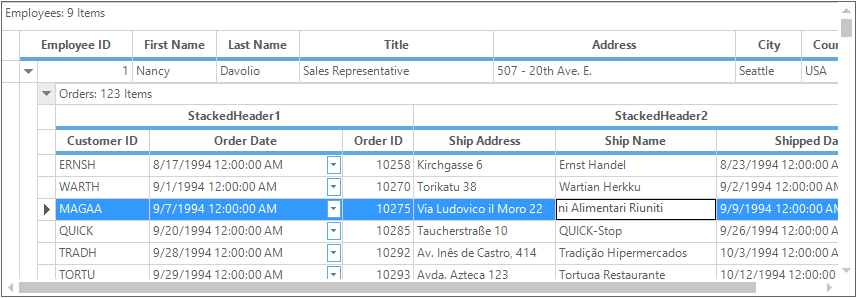
Appearance
The user can change the appearance of the StackedHeader in couple of ways. For changing the appearance of the whole stacked header, you can make use of the Appearance.StackedHeaderCell property. If you want to change the individual stacked headers in each StackedHeader row, then change the appearance settings through GridStackedHeaderRow Descriptor.
Making changes for all stacked headers
For changing all the stacked header style properties then make use of the Appearance.StackedHeaderCell property. This property acts as GridTableCellStyleInfo class hence it contains all the style properties.
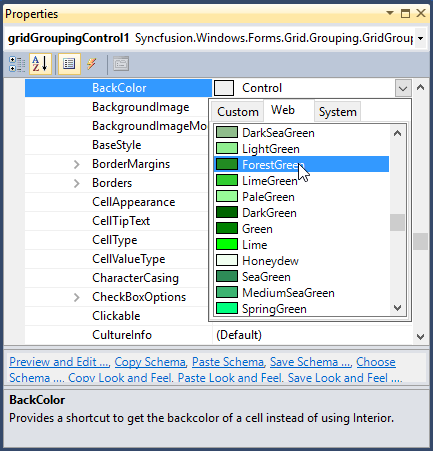
//Customizes appearance for all the stacked headers.
this.gridGroupingControl1.TableDescriptor.Appearance.StackedHeaderCell.TextColor = Color.White;
this.gridGroupingControl1.TableDescriptor.Appearance.StackedHeaderCell.BackColor = Color.ForestGreen;'Customizes appearance for all the stacked headers.
Me.gridGroupingControl1.TableDescriptor.Appearance.StackedHeaderCell.TextColor = Color.White
Me.gridGroupingControl1.TableDescriptor.Appearance.StackedHeaderCell.BackColor = Color.ForestGreen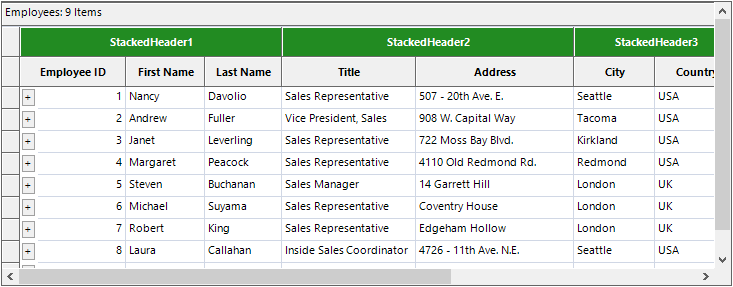
Making changes for individual stacked headers
For changing the individual stacked headers then make use of the GridStackedHeaderRow descriptor and change the color for individual stack header cells. This can be done in designer as well as in code behind.
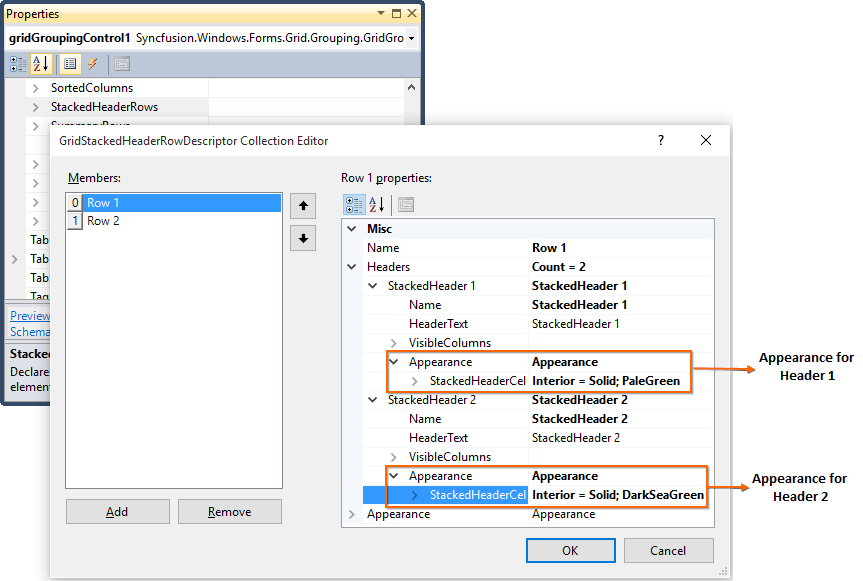
// Create an object for GridStackedHeaderRowDescriptor
GridStackedHeaderRowDescriptor gridStackedHeaderRowDescriptor1 = new GridStackedHeaderRowDescriptor();
gridStackedHeaderRowDescriptor1.Name = "Row 1";
// Create an object for GridStackedHeaderDescriptor
GridStackedHeaderDescriptor gridStackedHeaderDescriptor1 = new GridStackedHeaderDescriptor();
// Change the required appearance for that object
gridStackedHeaderDescriptor1.Appearance.StackedHeaderCell.TextColor = System.Drawing.Color.Black;
gridStackedHeaderDescriptor1.Appearance.StackedHeaderCell.BackColor = Color.ForestGreen;
// Set the name and header text for that object
gridStackedHeaderDescriptor1.HeaderText = "Header One";
gridStackedHeaderDescriptor1.Name = "StackedHeader 1";
// Add the required visible column range in this object
gridStackedHeaderDescriptor1.VisibleColumns.AddRange(new GridStackedHeaderVisibleColumnDescriptor[] {
new Syncfusion.Windows.Forms.Grid.Grouping.GridStackedHeaderVisibleColumnDescriptor("OrderDate"),
new Syncfusion.Windows.Forms.Grid.Grouping.GridStackedHeaderVisibleColumnDescriptor("Freight"),
new Syncfusion.Windows.Forms.Grid.Grouping.GridStackedHeaderVisibleColumnDescriptor("RequiredDate")});
// Add the appearance changed stacked header to the row stack header
gridStackedHeaderRowDescriptor1.Headers.Add(gridStackedHeaderDescriptor1);' Create an object for GridStackedHeaderRowDescriptor
Dim gridStackedHeaderRowDescriptor1 As New GridStackedHeaderRowDescriptor()
gridStackedHeaderRowDescriptor1.Name = "Row 1"
' Create an object for GridStackedHeaderDescriptor
Dim gridStackedHeaderDescriptor1 As New GridStackedHeaderDescriptor()
' Change the required appearance for that object
gridStackedHeaderDescriptor1.Appearance.StackedHeaderCell.TextColor = System.Drawing.Color.Black
gridStackedHeaderDescriptor1.Appearance.StackedHeaderCell.BackColor = Color.ForestGreen
' Set the name and header text for that object
gridStackedHeaderDescriptor1.HeaderText = "Header One"
gridStackedHeaderDescriptor1.Name = "StackedHeader 1"
' Add the required visible column range in this object
gridStackedHeaderDescriptor1.VisibleColumns.AddRange(New GridStackedHeaderVisibleColumnDescriptor() { New Syncfusion.Windows.Forms.Grid.Grouping.GridStackedHeaderVisibleColumnDescriptor("OrderDate"), New Syncfusion.Windows.Forms.Grid.Grouping.GridStackedHeaderVisibleColumnDescriptor("Freight"), New Syncfusion.Windows.Forms.Grid.Grouping.GridStackedHeaderVisibleColumnDescriptor("RequiredDate")})
' Add the appearance changed stacked header to the row stack header
gridStackedHeaderRowDescriptor1.Headers.Add(gridStackedHeaderDescriptor1)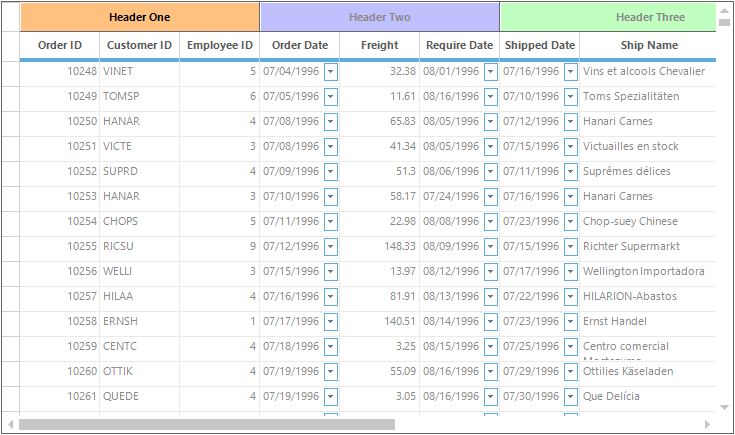
Multi-Stacked Headers
Multiple stacked headers can be achieved in GridGroupingControl by just adding the required number of rows using the TableDescriptor.StackedHeaderRows property.
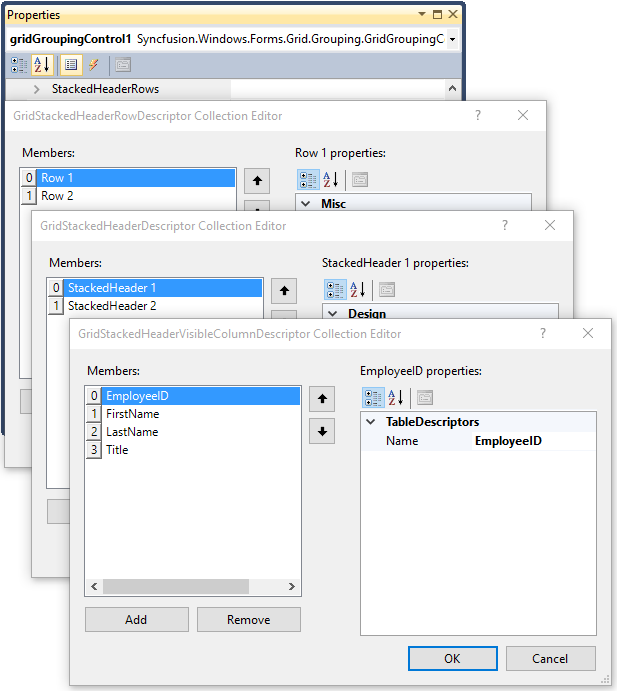
// Step 1: Creating StackedHeaderDescriptor for adding stacked columns
GridStackedHeaderDescriptor stackedHeaderDescriptor1 = new GridStackedHeaderDescriptor("groupheader1", "GroupStackedHeader1");
GridStackedHeaderDescriptor shd2 = new GridStackedHeaderDescriptor("header1", "StackedHeader1");
// Step 2: Adding visible columns to the StackedHeaderDescriptor
shd2.VisibleColumns.Add(new GridStackedHeaderVisibleColumnDescriptor("EmployeeID"));
shd2.VisibleColumns.Add(new GridStackedHeaderVisibleColumnDescriptor("FirstName"));
shd2.VisibleColumns.Add(new GridStackedHeaderVisibleColumnDescriptor("LastName"));
shd2.VisibleColumns.Add(new GridStackedHeaderVisibleColumnDescriptor("Title"));
stackedHeaderDescriptor1.VisibleColumns.Add(new GridStackedHeaderVisibleColumnDescriptor("EmployeeID"));
stackedHeaderDescriptor1.VisibleColumns.Add(new GridStackedHeaderVisibleColumnDescriptor("FirstName"));
// Step 3: Adding StackedHeaderDescriptor to the GridStackedHeaderRowDescriptor collection
GridStackedHeaderRowDescriptor stackedHeaderRowDescriptor1 = new GridStackedHeaderRowDescriptor("Row1",
new GridStackedHeaderDescriptor[] { stackedHeaderDescriptor1 });
GridStackedHeaderRowDescriptor stackedHeaderRowDescriptor2 = new GridStackedHeaderRowDescriptor("Row2",
new GridStackedHeaderDescriptor[] { shd2 });
// Step 4: Add the GridStackedRowHeaderDescriptor collection to the StackedHeaderRows
this.gridGroupingControl1.TableDescriptor.StackedHeaderRows.Add(stackedHeaderRowDescriptor1);
this.gridGroupingControl1.TableDescriptor.StackedHeaderRows.Add(stackedHeaderRowDescriptor2);' Step 1: Creating StackedHeaderDescriptor for adding stacked columns
Dim stackedHeaderDescriptor1 As New GridStackedHeaderDescriptor("groupheader1", "GroupStackedHeader1")
Dim shd2 As New GridStackedHeaderDescriptor("header1", "StackedHeader1")
' Step 2: Adding visible columns to the StackedHeaderDescriptor
shd2.VisibleColumns.Add(New GridStackedHeaderVisibleColumnDescriptor("EmployeeID"))
shd2.VisibleColumns.Add(New GridStackedHeaderVisibleColumnDescriptor("FirstName"))
shd2.VisibleColumns.Add(New GridStackedHeaderVisibleColumnDescriptor("LastName"))
shd2.VisibleColumns.Add(New GridStackedHeaderVisibleColumnDescriptor("Title"))
stackedHeaderDescriptor1.VisibleColumns.Add(New GridStackedHeaderVisibleColumnDescriptor("EmployeeID"))
stackedHeaderDescriptor1.VisibleColumns.Add(New GridStackedHeaderVisibleColumnDescriptor("FirstName"))
' Step 3: Adding StackedHeaderDescriptor to the GridStackedHeaderRowDescriptor collection
Dim stackedHeaderRowDescriptor1 As New GridStackedHeaderRowDescriptor("Row1", New GridStackedHeaderDescriptor() { stackedHeaderDescriptor1 })
Dim stackedHeaderRowDescriptor2 As New GridStackedHeaderRowDescriptor("Row2", New GridStackedHeaderDescriptor() { shd2 })
' Step 4: Add the GridStackedRowHeaderDescriptor collection to the StackedHeaderRows
Me.gridGroupingControl1.TableDescriptor.StackedHeaderRows.Add(stackedHeaderRowDescriptor1)
Me.gridGroupingControl1.TableDescriptor.StackedHeaderRows.Add(stackedHeaderRowDescriptor2)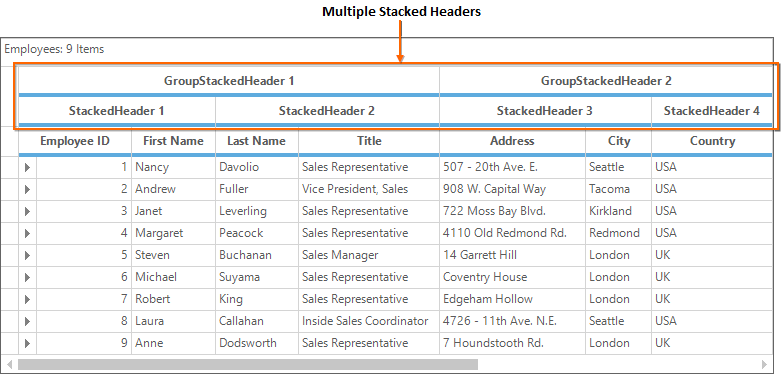
FieldChooser for StackedHeaders
User can show or hide the columns of a stacked header in a grid by using the FieldChooser functionality.
// Adding FieldChooser support to the GridGroupingControl
FieldChooser fieldChooser = new FieldChooser(this.gridGroupingControl1);' Adding FieldChooser support to the GridGroupingControl
Dim fieldChooser As New FieldChooser(Me.gridGroupingControl1)NOTE
For more information, refer the dashboard sample which is located in this path <Installed_Location>\Syncfusion\EssentialStudio\<Version_Number>\Windows\Grid.Grouping.Windows\Samples\Layout Customization\Stacked Headers Demo\CS

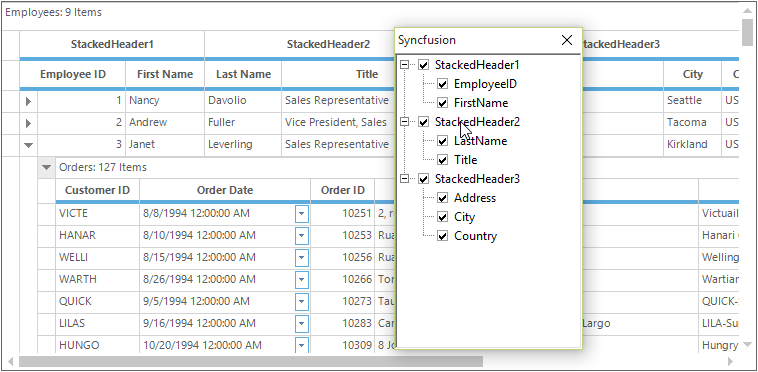
Displaying only Stacked Header Columns
By default, FieldChooser Dialog will be loaded with the inner columns along with the stacked headers. To display only the stacked headers make us of the EnableColumnsInView property.
FieldChooser fieldChooser = new FieldChooser(this.gridGroupingControl1);
// Do not display the inner columns of stacked header in FieldChooser
fieldChooser.EnableColumnsInView = false;Dim fieldChooser As New FieldChooser(Me.gridGroupingControl1)
' Do not display the inner columns of stacked header in FieldChooser
fieldChooser.EnableColumnsInView = False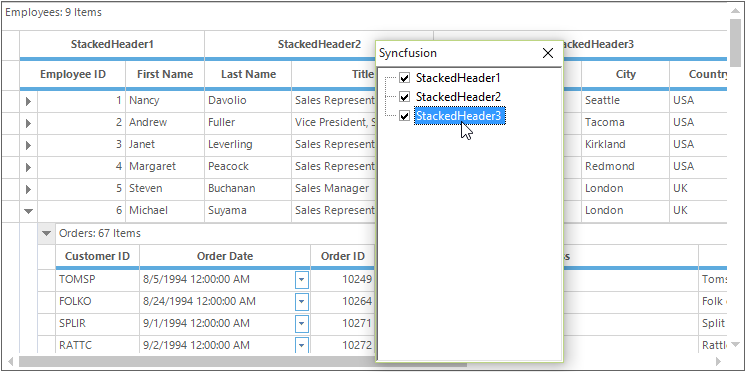
Hiding Stacked Headers
The display of stacked headers can be hidden by setting the ShowStackedHeaders property to false. This can be achieved for parent table, child table and nested child table by using the properties TopLevelGroupOptions.ShowStackedHeaders, ChildGroupOptions.ShowStackedHeaders and NestedTableGroupOptions.ShowStackedHeaders respectively.
// Hides the visibility of stacked headers in Parent table
this.gridGroupingControl1.TopLevelGroupOptions.ShowStackedHeaders = false;
// Hides the visibility of stacked headers in Child table
this.gridGroupingControl1.ChildGroupOptions.ShowStackedHeaders = false;
// Hides the visibility of stacked headers in Nested Child table
this.gridGroupingControl1.NestedTableGroupOptions.ShowStackedHeaders = false;' Hides the visibility of stacked headers in Parent table
Me.gridGroupingControl1.TopLevelGroupOptions.ShowStackedHeaders = False
' Hides the visibility of stacked headers in Child table
Me.gridGroupingControl1.ChildGroupOptions.ShowStackedHeaders = False
' Hides the visibility of stacked headers in Nested Child table
Me.gridGroupingControl1.NestedTableGroupOptions.ShowStackedHeaders = FalseClearing Stacked Headers
All the stacked headers can be removed by using the StackedHeaders.Clear method.
// Clears all the stacked headers in GridGroupingControl
this.gridGroupingControl1.TableDescriptor.StackedHeaderRows.Clear();' Clears all the stacked headers in GridGroupingControl
Me.gridGroupingControl1.TableDescriptor.StackedHeaderRows.Clear()Removing Stacked Headers
In multiple stacked headers, there will be more than one stacked row headers. So for removing a particular stacked row header, make use of the StackedHeaders.Remove and StackedHeaders.RemoveAt methods. These methods will remove the mentioned stacked row header by its name or index.
// Removes the stacked header with name "Row1"
this.gridGroupingControl1.TableDescriptor.StackedHeaderRows.Remove("Row1");
// Removes the stacked header which is located in the zeroth index
this.gridGroupingControl1.TableDescriptor.StackedHeaderRows.RemoveAt(0);' Removes the stacked header with name "Row1"
Me.gridGroupingControl1.TableDescriptor.StackedHeaderRows.Remove("Row1")
' Removes the stacked header which is located in the zeroth index
Me.gridGroupingControl1.TableDescriptor.StackedHeaderRows.RemoveAt(0)Multi-Row Record
GridGroupingControl offers built-in support for Multi-Row Records. Using this support user can modify the default alignment of visible columns. It allows the records to span across multiple rows and columns. This can be achieved by using TableDescriptor.ColumnSets.
ColumnSets act as superset of TableDescriptor.Columns collection. Once ColumnSets are defined, the grid will loop through the collection and organize data display accordingly.
Adding Column Spans through Designer
To create ColumnSets that defines ColumnSpans for a grid, select TableDescriptor.ColumnSets property in the property window. This will open GridColumnSetDescriptor collection editor that will let you specify the columns to span and the range for each of the columns.

Adding Column Spans through Code
The below steps needs to be followed for spanning the records across multiple rows.
1.Define GridColumnSpanDescriptor for each column to be spanned across grid rows or columns. Specify the range that the column spans. Rows and Columns are zero-based.
// Create objects for GridColumnSpanDescriptor
GridColumnSpanDescriptor columnSpanDescriptor0 = new GridColumnSpanDescriptor("ProductID");
GridColumnSpanDescriptor columnSpanDescriptor1 = new GridColumnSpanDescriptor("ProductName");
GridColumnSpanDescriptor columnSpanDescriptor2 = new GridColumnSpanDescriptor("SupplierID");
GridColumnSpanDescriptor columnSpanDescriptor3 = new GridColumnSpanDescriptor("CategoryID");
// Add the required ranges for the created object
columnSpanDescriptor0.Range = GridRangeInfo.Cells(0, 0, 1, 0);
columnSpanDescriptor1.Range = GridRangeInfo.Cells(0, 1, 0, 2);
columnSpanDescriptor2.Range = GridRangeInfo.Cells(1, 1, 1, 1);
columnSpanDescriptor3.Range = GridRangeInfo.Cells(1, 2, 1, 2);' Create objects for GridColumnSpanDescriptor
Dim columnSpanDescriptor0 As New GridColumnSpanDescriptor("ProductID")
Dim columnSpanDescriptor1 As New GridColumnSpanDescriptor("ProductName")
Dim columnSpanDescriptor2 As New GridColumnSpanDescriptor("SupplierID")
Dim columnSpanDescriptor3 As New GridColumnSpanDescriptor("CategoryID")
' Add the required ranges for the created object
columnSpanDescriptor0.Range = GridRangeInfo.Cells(0, 0, 1, 0)
columnSpanDescriptor1.Range = GridRangeInfo.Cells(0, 1, 0, 2)
columnSpanDescriptor2.Range = GridRangeInfo.Cells(1, 1, 1, 1)
columnSpanDescriptor3.Range = GridRangeInfo.Cells(1, 2, 1, 2)2.Create a GridColumnSetDescriptor whose ColumnSpans property stores information about columns that needs to be spanned. Hence, it is necessary to initialize ColumnSpans property with columns that needs to be spread.
// Create object for GridColumnSetDescriptor
GridColumnSetDescriptor columnSetDescriptor = new GridColumnSetDescriptor();
// Add the column span descriptor to the created
// columns set descriptor
columnSetDescriptor.ColumnSpans.Add(columnSpanDescriptor0);
columnSetDescriptor.ColumnSpans.Add(columnSpanDescriptor1);
columnSetDescriptor.ColumnSpans.Add(columnSpanDescriptor2);
columnSetDescriptor.ColumnSpans.Add(columnSpanDescriptor3);' Create object for GridColumnSetDescriptor
Dim columnSetDescriptor As New GridColumnSetDescriptor()
' Add the column span descriptor to the created
' columns set descriptor
columnSetDescriptor.ColumnSpans.Add(columnSpanDescriptor0)
columnSetDescriptor.ColumnSpans.Add(columnSpanDescriptor1)
columnSetDescriptor.ColumnSpans.Add(columnSpanDescriptor2)
columnSetDescriptor.ColumnSpans.Add(columnSpanDescriptor3)3.Finally bind this ColumnSets to the grid by adding the above created GridColumnSetDescriptor into the TableDescriptor.ColumnSets property.
// Add the column set descriptor to the ColumnSets property
this.gridGroupingControl1.TableDescriptor.ColumnSets.Add(columnSetDescriptor);' Add the column set descriptor to the ColumnSets property
Me.gridGroupingControl1.TableDescriptor.ColumnSets.Add(columnSetDescriptor)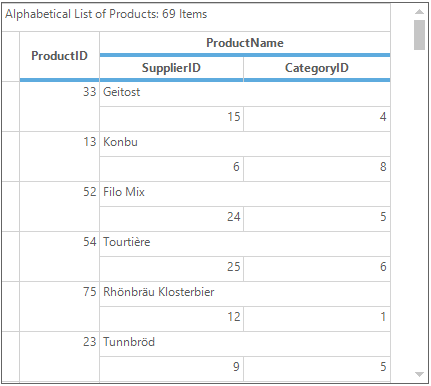
NOTE
For more information regarding the Multi-Row record, refer our dashboard sample which is located in this path <Installed_Location>\Syncfusion\EssentialStudio\<Version_Number>\Windows\Grid.Grouping.Windows\Samples\Layout Customization\Record Customization Demo\
Clearing ColumnSpans
The column spans can be removed from the GridGroupingControl by using the ColumnSets.Reset method. This method will clear all the collection of column sets available.
// Clears all the collection
this.gridGroupingControl1.TableDescriptor.ColumnSets.Reset();' Clears all the collection
Me.gridGroupingControl1.TableDescriptor.ColumnSets.Reset()Removing ColumnSpans
Particular ColumnSpans can be removed from the GridGroupingControl by using the ColumnSets.Remove and ColumnSets.RemoveAt method. These methods will remove the mentioned column name or index of column sets.
// Remove the ColumnSets at index 1
this.gridGroupingControl1.TableDescriptor.ColumnSets.RemoveAt(1);' Remove the ColumnSets at index 1
Me.gridGroupingControl1.TableDescriptor.ColumnSets.RemoveAt(1)Field Chooser
User can handle the visibility of columns through FieldChooser dialog. It can be done by initializing FieldChooser class where the constructor takes a parameter as a GridGroupingControl object. The GridHelperClasses.Windows assembly provide this support.
On enabling the FieldChooser, a dialog box will be opened when right clicked on column headers. This dialog box will list all the column names with check boxes beside them. The required columns can be made visible in the grid by selecting the check box adjacent to the required column.
// Adding FieldChooser support to the GridGroupingControl
FieldChooser fieldChooser = new FieldChooser(this.gridGroupingControl1);' Adding FieldChooser support to the GridGroupingControl
Dim fieldChooser As New FieldChooser(Me.gridGroupingControl1)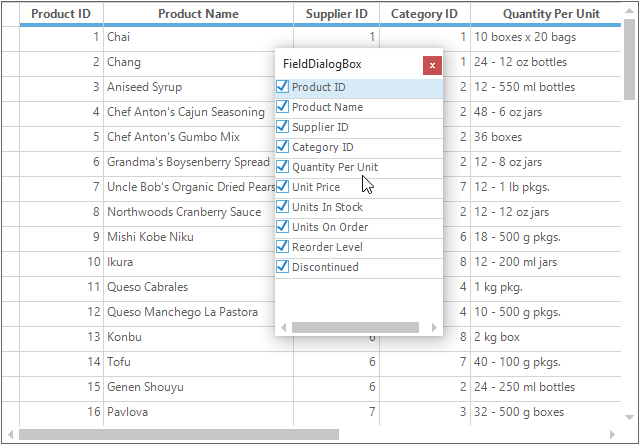
Changing caption text for FieldChooser dialog
FieldChooser events are used to customize FieldChooser dialog box. For changing the caption text of the FieldChooser dialog box, make use of the FieldChooserShowing event. In this event, you can make use of thee.Caption property to change the text.
FieldChooser fieldChooser = new FieldChooser(this.gridGroupingControl1);
fieldChooser.Grid.FieldChooserShowing += Grid_FieldChooserShowing;
void Grid_FieldChooserShowing(object sender, Syncfusion.Windows.Forms.Grid.FieldChooserShowingEventArgs e)
{
//Setting the caption for FieldChooser dialog
e.Caption = "Syncfusion";
}Dim fieldChooser As New FieldChooser(Me.gridGroupingControl1)
fieldChooser.Grid.FieldChooserShowing += Grid_FieldChooserShowing
Private Sub Grid_FieldChooserShowing(ByVal sender As Object, ByVal e As Syncfusion.Windows.Forms.Grid.FieldChooserShowingEventArgs)
'Setting the caption for FieldChooser dialog
e.Caption = "Syncfusion"
End Sub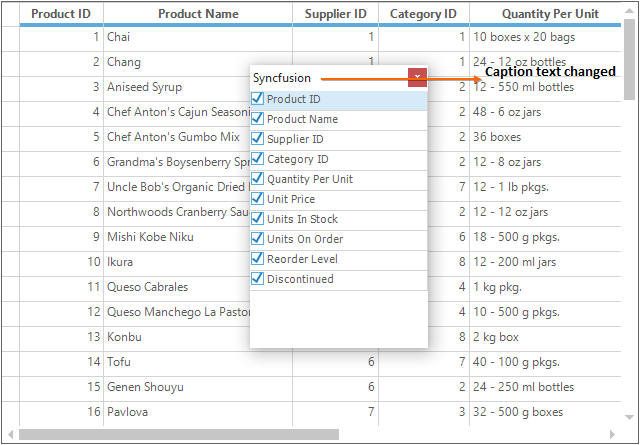
FieldChooser events are used to customize FieldChooser dialog box. It allows the user to modify control of the FieldChooser dialog and change its caption name. It has events to perform operations in FieldChooser dialog box such as FieldChooserShowing, FieldChooserShown, FieldChooserClosing and FieldChooserClosed events.
Updating Layout on Closing
By default, the GridGroupingControl will update the changes in the visibility of the columns while check/ unchecking the checkbox in the FieldChooser dialog box. To update the visibility or invisibility of columns after closing the FieldChooser Dialog box, set the DeferLayoutUpdate property to ‘True’.
// Adding FieldChooser support to the GridGroupingControl
FieldChooser fieldChooser = new FieldChooser(this.gridGroupingControl1);
// Update while closing the FieldChooser Dialog
fieldChooser.DeferLayoutUpdate = true;' Adding FieldChooser support to the GridGroupingControl
Dim fieldChooser As New FieldChooser(Me.gridGroupingControl1)
' Update while closing the FieldChooser Dialog
fieldChooser.DeferLayoutUpdate = TrueRestricting the display of FieldChooser Dialog
The user can restrict the FieldChooser dialog box before displaying it by using the FieldChooserShowing event. In this event, set the e.Cancel property as true.
this.gridGroupingControl1.FieldChooserShowing += new Syncfusion.Windows.Forms.Grid.FieldChooserShowingEventHandler(gridGroupingControl1_FieldChooserShowing);
void gridGroupingControl1_FieldChooserShowing(object sender, Syncfusion.Windows.Forms.Grid.FieldChooserShowingEventArgs e)
{
// Stops the FieldChooser dialog box from showing.
e.Cancel = true;
}AddHandler gridGroupingControl1.FieldChooserShowing, AddressOf gridGroupingControl1_FieldChooserShowing
Private Sub gridGroupingControl1_FieldChooserShowing(ByVal sender As Object, ByVal e As Syncfusion.Windows.Forms.Grid.FieldChooserShowingEventArgs)
' Stops the FieldChooser dialog box from showing.
e.Cancel = True
End SubRestricting the closing of FieldChooser Dialog
Users can restrict the closing of FieldChooser dialog by using the FieldChooserClosing event. Check the required condition and set the e.Cancel property as true to restrict the closing of the FieldChooser dialog.
FieldChooser fieldChooser = new FieldChooser(this.gridGroupingControl1);
fieldChooser.Grid.FieldChooserClosing += Grid_FieldChooserClosing;
void Grid_FieldChooserClosing(object sender, Syncfusion.Windows.Forms.Grid.FieldChooserClosingEventArgs e)
{
//Add required condition
DialogResult result1 = MessageBox.Show("Do you want to close the FieldChooser dialog?", "Syncfusion", MessageBoxButtons.YesNo);
if (result1 == System.Windows.Forms.DialogResult.No)
e.Cancel = true;// will restrict the closing of FieldChooser dialog box
}Dim fieldChooser As New FieldChooser(Me.gridGroupingControl1)
fieldChooser.Grid.FieldChooserClosing += Grid_FieldChooserClosing
Private Sub Grid_FieldChooserClosing(ByVal sender As Object, ByVal e As Syncfusion.Windows.Forms.Grid.FieldChooserClosingEventArgs)
'Add required condition
Dim result1 As DialogResult = MessageBox.Show("Do you want to close the FieldChooser dialog?", "Syncfusion", MessageBoxButtons.YesNo)
If result1 = System.Windows.Forms.DialogResult.No Then
e.Cancel = True ' will restrict the closing of FieldChooser dialog box
End If
End Sub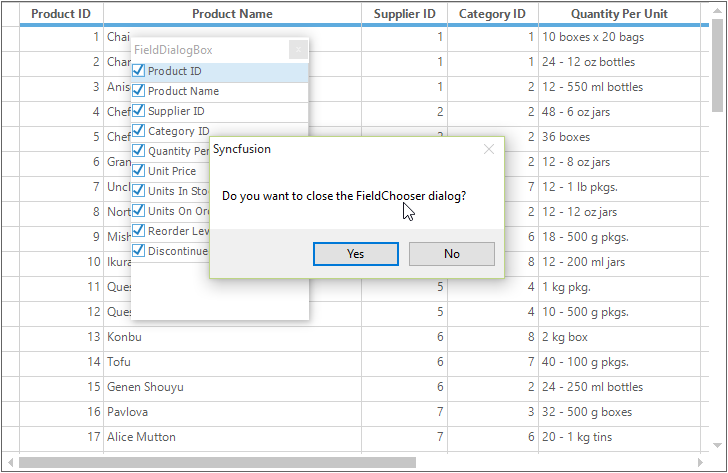
NOTE
FieldChooser support can also be added in StackedHeaders.
Remove Hidden Columns from FieldChooser Dialog
To remove the hidden columns from the FieldChooser dialog, it is necessary to bypass the original column collection in the FieldChooser with a cloned GridColumnDescriptorCollection. The following steps illustrates how to do this:
- Get the collection of the visible columns that are removed from the column collection.
- Create a cloned column collection
GridColumnDescriptorCollectionfrom theTableDescriptor.
Pass the cloned collection object as an argument to the FieldChooser to ensure that changes are made correctly.
//Removes Visible Columns.
this.gridGroupingControl1.TableDescriptor.VisibleColumns.Remove("Name3");
//Creates GridColumnDescriptorCollection column collection.
GridColumnDescriptorCollection collection =
this.gridGroupingControl1.TableDescriptor.Columns.Clone();
//Detaches visible column, which is likely to be removed from this cloned collection also.
collection.Remove("Name3");
//Passes the collection as an argument to the Field Chooser object.
FieldChooser fieldChooser = new FieldChooser(this.gridGroupingControl1, collection);'Removes Visible Columns.
Me.gridGroupingControl1.TableDescriptor.VisibleColumns.Remove("Name3")
'Creates a GridColumnDescriptorCollection column collection.
Dim collection As GridColumnDescriptorCollection =
Me.gridGroupingControl1.TableDescriptor.Columns.Clone()
'Detaches the visible column, which is likely to be removed from this cloned collection also.
collection.Remove("Name3")
'Passes the collection as an argument to the Field Chooser object.
Dim fieldChooser As New FieldChooser(Me.gridGroupingControl1, collection)UnWiring FieldChooser
To unwire FieldChooser from the GridGroupingControl, make use of the UnWireGrid method. This method will disable the FieldChooser.
// Adding FieldChooser support to the GridGroupingControl
FieldChooser fieldChooser = new FieldChooser(this.gridGroupingControl1);
// Disables the FieldChooser support for the added GridGroupingControl
fieldChooser.UnWireGrid();' Adding FieldChooser support to the GridGroupingControl
Dim fieldChooser As New FieldChooser(Me.gridGroupingControl1)
' Disables the FieldChooser support for the added GridGroupingControl
fieldChooser.UnWireGrid()Freezing Columns
It is possible to freeze columns like in Excel by using the TableDescriptor.FrozenColumn. This property will prevent the mentioned column from scrolling.
// Freezes the column named “ParentName” in the grid
gridGroupingControl1.TableDescriptor.FrozenColumn = "ParentName";' Freezes the column named “ParentName” in the grid
gridGroupingControl1.TableDescriptor.FrozenColumn = "ParentName"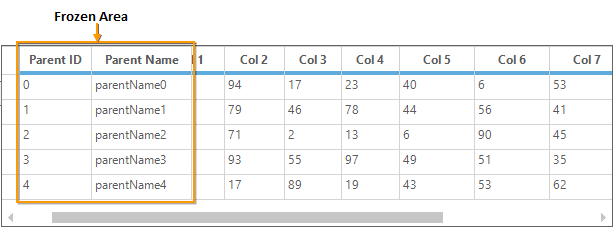
Freezing Columns in Nested Table
It is also possible to freeze columns of nested table in a GridGroupingControl by using the TableDescriptor.FrozenColumn. First you have to get the TableDescriptor of the required child table and then have to access the FrozenColumn property.
NOTE
In a nested grid with frozen columns, to make sure that columns in nested records are properly aligned, TrackWidthOfParentColumn property can be used.
// Freezes the column in the ChildTable.
this.gridGroupingControl1.GetTableDescriptor("MyChildTable").FrozenColumn = "Name";
// Freezes the column in Nested ChildTable
this.gridGroupingControl1.GetTableDescriptor("MyGrandChildTable").FrozenColumn = "Name";' Freezes the column in the ChildTable.
Me.gridGroupingControl1.GetTableDescriptor("MyChildTable").FrozenColumn = "Name"
' Freezes the column in Nested ChildTable
Me.gridGroupingControl1.GetTableDescriptor("MyGrandChildTable").FrozenColumn = "Name"
NOTE
For more information on Freezing columns, refer the dashboard sample located in this path <Installed_Location>\Syncfusion\EssentialStudio\<Version_Number>\Windows\Grid.Grouping.Windows\Samples\Layout Customization\Frozen Column Demo\
Freezing Specified Columns
It is possible to freeze specified columns in GridGroupingControl by using the Cols.FreezeRange method. Set the column range in this method by mentioning the index values.
// Freezes the columns of range from one to three.
this.gridGroupingControl1.TableModel.Cols.FreezeRange(1, 3);' Freezes the columns of range from one to three.
Me.gridGroupingControl1.TableModel.Cols.FreezeRange(1, 3)Freezing the Caption Row
GridGroupingControl provides support to freeze caption row to make sure it stays visible while scrolling content to the left or right. With FreezeCaption property, you can freeze or unfreeze the caption row in the Grid Grouping control.
// Freezes the caption row
this.gridGroupingControl.FreezeCaption = true'Freezes the caption row
Me.gridGroupingControl.FreezeCaption = TrueNOTE
To view a sample on Freezing the Caption Row, refer the dashboard sample which is located in this path <Installed_Location>\Syncfusion\EssentialStudio\<Version_Number>\Windows\Grid.Grouping.Windows\Samples\Grouping\Grouping Events Demo
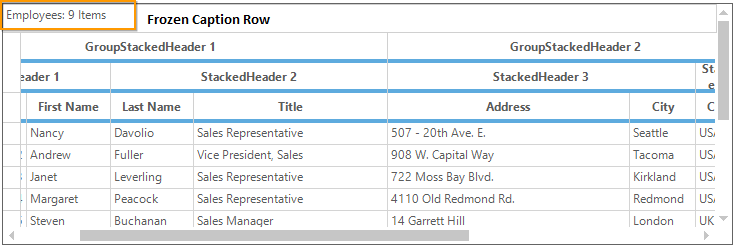
Enabling ScrollBar when the Freeze Columns exceeds the Client Area
In GridGroupingControl, if freeze columns exceed client area then the horizontal scroll bar will become invisible. To overcome this some of the customizations has to be done. You have to make use of the ResizeEnd and HScrollPixelPosChanging events and need to check certain conditions in it.
this.ResizeEnd += new EventHandler(Form1_ResizeEnd);
this.oGrid.TableControl.HScrollPixelPosChanging += new GridScrollPositionChangingEventHandler(TableControl_HScrollPixelPosChanging);
void Form1_ResizeEnd(object sender, EventArgs e)
{
int fieldIndex = Convert.ToInt32(textBox1.Text);
var col = oGrid.TableDescriptor.VisibleColumns[fieldIndex-1];
var last = oGrid.TableControl.ViewLayout.LastVisibleCol;
if (col != null)
{
if (last < fieldIndex + 2 && buttonClick)
{
oGrid.TableModel.ResetColHiddenEntries();
oGrid.TableDescriptor.FrozenColumn = "";
oGrid.TableControl.SetCurrentHScrollPixelPos(1);
notFrozenView = true;
frozenView = false;
}
else if (buttonClick)
{
oGrid.TableDescriptor.FrozenColumn = col.Name;
frozenView = true;
notFrozenView = false;
}
}
}
void TableControl_HScrollPixelPosChanging(object sender, GridScrollPositionChangingEventArgs e)
{
int fieldIndex = Convert.ToInt32(textBox1.Text);
var col = oGrid.TableDescriptor.VisibleColumns[fieldIndex - 1];
int columnPosition = 0;
int pixelDelta;
oGrid.TableControl.HScrollPixelPosToColIndex(e.ScrollPosition, out columnPosition, out pixelDelta);
var LeftmostPixel=oGrid.TableControl.GetHScrollPixelMinimum();
var last = oGrid.TableControl.ViewLayout.LastVisibleCol;
var vCount = oGrid.TableControl.ViewLayout.VisibleColumnsList.Count;
if (columnPosition==0)
{
e.Cancel = true;
}
if (notFrozenView && buttonClick && last==fieldIndex+1)
{
for (int i = 1; i <= fieldIndex-(vCount-3); i++)
{
GridColHidden hid = new GridColHidden(i);
oGrid.TableModel.ColHiddenEntries.Add(hid);
}
oGrid.TableDescriptor.FrozenColumn = col.Name;
unfreeze = true;
}
if (columnPosition == fieldIndex + 1 && LeftmostPixel == e.ScrollPosition && unfreeze && !frozenView && buttonClick)
{
oGrid.TableModel.ResetColHiddenEntries();
oGrid.TableDescriptor.FrozenColumn = "";
unfreeze = false;
}
}AddHandler ResizeEnd, AddressOf Form1_ResizeEnd
Private Me.oGrid.TableControl.HScrollPixelPosChanging += New GridScrollPositionChangingEventHandler(AddressOf TableControl_HScrollPixelPosChanging)
Private Sub Form1_ResizeEnd(ByVal sender As Object, ByVal e As EventArgs)
Dim fieldIndex As Integer = Convert.ToInt32(textBox1.Text)
Dim col = oGrid.TableDescriptor.VisibleColumns(fieldIndex-1)
Dim last = oGrid.TableControl.ViewLayout.LastVisibleCol
If col IsNot Nothing Then
If last < fieldIndex + 2 AndAlso buttonClick Then
oGrid.TableModel.ResetColHiddenEntries()
oGrid.TableDescriptor.FrozenColumn = ""
oGrid.TableControl.SetCurrentHScrollPixelPos(1)
notFrozenView = True
frozenView = False
ElseIf buttonClick Then
oGrid.TableDescriptor.FrozenColumn = col.Name
frozenView = True
notFrozenView = False
End If
End If
End Sub
Private Sub TableControl_HScrollPixelPosChanging(ByVal sender As Object, ByVal e As GridScrollPositionChangingEventArgs)
Dim fieldIndex As Integer = Convert.ToInt32(textBox1.Text)
Dim col = oGrid.TableDescriptor.VisibleColumns(fieldIndex - 1)
Dim columnPosition As Integer = 0
Dim pixelDelta As Integer
oGrid.TableControl.HScrollPixelPosToColIndex(e.ScrollPosition, columnPosition, pixelDelta)
Dim LeftmostPixel =oGrid.TableControl.GetHScrollPixelMinimum()
Dim last = oGrid.TableControl.ViewLayout.LastVisibleCol
Dim vCount = oGrid.TableControl.ViewLayout.VisibleColumnsList.Count
If columnPosition=0 Then
e.Cancel = True
End If
If notFrozenView AndAlso buttonClick AndAlso last Is fieldIndex+1 Then
For i As Integer = 1 To fieldIndex-(vCount-3)
Dim hid As New GridColHidden(i)
oGrid.TableModel.ColHiddenEntries.Add(hid)
Next i
oGrid.TableDescriptor.FrozenColumn = col.Name
unfreeze = True
End If
If columnPosition = fieldIndex + 1 AndAlso LeftmostPixel Is e.ScrollPosition AndAlso unfreeze AndAlso (Not frozenView) AndAlso buttonClick Then
oGrid.TableModel.ResetColHiddenEntries()
oGrid.TableDescriptor.FrozenColumn = ""
unfreeze = False
End If
End SubTo know in detail with sample, refer the KB article which explains about this.